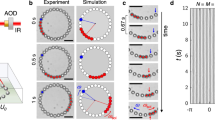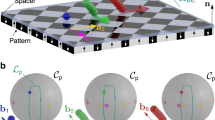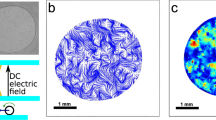Abstract
When particles are driven across crystalline surfaces, their trajectories do not necessarily follow the applied force but become locked to the substrate lattice directions. Such directional locking, being relevant for bottom-up nanodevice assembly1,2 and particle sorting3,4,5,6, has been intensively studied for isolated or single particles3,4,5,6,7,8,9,10,11. Here we experimentally study the motion of extended colloidal clusters sliding over a periodically corrugated surface. We observe that both their orientational and centre-of-mass motions become locked into directions not coinciding with the substrate symmetry but determined by the geometrical moiré superstructure formed by the cluster and substrate lattices. In general, such moiré superstructures are not strictly periodic, which leads to competing locking directions depending on cluster size. Remarkably, we uncover a dependence of directional locking on the higher Fourier components of the surface corrugation profile, which can be tuned on atomic surfaces via the external load12,13. This allows for an unprecedented control of cluster steering relevant for nanomanipulations on surfaces.
This is a preview of subscription content, access via your institution
Access options
Access Nature and 54 other Nature Portfolio journals
Get Nature+, our best-value online-access subscription
$29.99 / 30 days
cancel any time
Subscribe to this journal
Receive 12 print issues and online access
$209.00 per year
only $17.42 per issue
Buy this article
- Purchase on Springer Link
- Instant access to full article PDF
Prices may be subject to local taxes which are calculated during checkout




Similar content being viewed by others
Data availability
The data that support the findings of this study are available from the corresponding author upon request.
References
Sheehan, P. E. & Lieber, C. M. Nanotribology and nanofabrication of MoO3 structures by atomic force microscopy. Science 272, 1158–1161 (1996).
Trillitzsch, F. et al. Directional and angular locking in the driven motion of Au islands on MoS2. Phys. Rev. B 98, 165417 (2018).
Huang, L. R., Cox, E. C., Austin, R. H. & Sturm, J. C. Continuous particle separation through deterministic lateral displacement. Science 304, 987–990 (2004).
Balvin, M., Sohn, E., Iracki, T., Drazer, G. & Frechette, J. Directional locking and the role of irreversible interactions in deterministic hydrodynamics separations in microfluidic devices. Phys. Rev. Lett. 103, 078301 (2009).
Wunsch, B. H. et al. Nanoscale lateral displacement arrays for the separation of exosomes and colloids down to 20 nm. Nat. Nanotechnol. 11, 936–940 (2016).
MacDonald, M. P., Spalding, G. C. & Dholakia, K. Microfluidic sorting in an optical lattice. Nature 426, 421–424 (2003).
Bohlein, T. & Bechinger, C. Experimental observation of directional locking and dynamical ordering of colloidal monolayers driven across quasiperiodic substrates. Phys. Rev. Lett. 109, 058301 (2012).
Reichhardt, C. & Nori, F. Phase locking, devil’s staircases, Farey trees, and Arnold tongues in driven vortex lattices with periodic pinning. Phys. Rev. Lett. 82, 414–417 (1999).
Reichhardt, C. & Olson Reichhardt, C. J. Directional locking effects and dynamics for particles driven through a colloidal lattice. Phys. Rev. E 69, 041405 (2004).
Gopinathan, A. & Grier, D. G. Statistically locked-In transport through periodic potential landscapes. Phys. Rev. Lett. 92, 130602 (2004).
Pelton, M., Ladavac, K. & Grier, D. G. Transport and fractionation in periodic potential-energy landscapes. Phys. Rev. E 70, 031108 (2004).
Bhushan, B., Israelachvili, J. N. & Landman, U. Nanotribology: friction, wear and lubrication at the atomic scale. Nature 374, 607–616 (1995).
Apostoli, C. et al. Velocity dependence of sliding friction on a crystalline surface. Beilstein J. Nanotechnol. 8, 2186–2199 (2017).
Eigler, D. M. & Schweizer, E. K. Positioning single atoms with a scanning tunnelling microscope. Nature 344, 524–526 (1990).
Guerra, R., Tartaglino, U., Vanossi, A. & Tosatti, E. Ballistic nanofriction. Nat. Mater. 9, 634–637 (2010).
Brazda, T. et al. Experimental observation of the Aubry transition in two-dimensional colloidal monolayers. Phys. Rev. X 8, 011050 (2018).
Braun, O. M. & Kivshar, Y. S. Nonlinear dynamics of the Frenkel–Kontorova model. Phys. Rep. 306, 1–108 (1998).
Nita, P., Casado, S., Dietzel, D., Schirmeisen, A. & Gnecco, E. Spinning and translational motion of Sb nanoislands manipulated on MoS2. Nanotechnology 24, 325302 (2013).
Kim, S., Shafiei, F., Ratchford, D. & Li, X. Controlled AFM manipulation of small nanoparticles and assembly of hybrid nanostructures. Nanotechnology 22, 115301 (2011).
Morin, A., Desreumaux, N., Caussin, J.-B. & Bartolo, D. Distortion and destruction of colloidal flocks in disordered environments. Nat. Phys. 13, 63–67 (2017).
Driscoll, M. et al. Unstable fronts and motile structures formed by microrollers. Nat. Phys. 13, 375–379 (2017).
Cao, X., Zhang, H. & Han, Y. Release of free-volume bubbles by cooperative-rearrangement regions during the deposition growth of a colloidal glass. Nat. Commun. 8, 362 (2017).
Bohlein, T., Mikhael, J. & Bechinger, C. Observation of kinks and antikinks in colloidal monolayers driven across ordered surfaces. Nat. Mater. 11, 126–130 (2012).
Libál, A. et al. Ice rule fragility via topological charge transfer in artificial colloidal ice. Nat. Commun. 9, 4146 (2018).
McGuire, M. J., Addai-Mensah, J. & Bremmell, K. E. Spectroscopic investigation of the adsorption mechanisms of polyacrylamide polymers onto iron oxide particles. J. Colloid Interface Sci. 299, 547–555 (2006).
Weissenborn, P. K., Warren, L. J. & Dunn, J. G. Optimisation of selective flocculation of ultrafine iron ore. Int. J. Miner. Process. 42, 191–213 (1994).
Henkelman, G., Uberuaga, B. P. & Jónsson, H. A climbing image nudged elastic band method for finding saddle points and minimum energy paths. J. Chem. Phys. 113, 9901–9904 (2000).
Song, Y. et al. Robust microscale superlubricity in graphite/hexagonal boron nitride layered heterojunctions. Nat. Mater. 17, 894–899 (2018).
Hod, O., Meyer, E., Zheng, Q. & Urbakh, M. Structural superlubricity and ultralow friction across the length scales. Nature 563, 485–492 (2018).
Koren, E. & Duerig, U. Moiré scaling of the sliding force in twisted bilayer graphene. Phys. Rev. B 94, 045401 (2016).
Walles, W. E. Role of flocculant molecular weight in the coagulation of suspensions. J. Colloid Interface Sci. 27, 797–803 (1968).
Rapp, B. E. Microfluidics: Modelling, Mechanics and Mathematics Ch. 9 (William Andrew Publishing, 2016).
Martinez-Pedrero, F. & Tierno, P. Magnetic propulsion of self-assembled colloidal carpets: efficient cargo transport via a conveyor-belt effect. Phys. Rev. Appl. 3, 051003 (2015).
Geerts, N. & Eiser, E. Flying colloidal carpets. Soft Matter 6, 664–669 (2010).
Crocker, J. C. & Grier, D. G. Methods of digital video microscopy for colloidal studies. J. Colloid Interface Sci. 179, 298–310 (1996).
Toxvaerd, S. & Dyre, J. C. Communication: shifted forces in molecular dynamics. J. Chem. Phys. 134, 081102 (2011).
Novaco, A. D. & McTague, J. P. Orientational epitaxy—the orientational ordering of incommensurate structures. Phys. Rev. Lett. 38, 1286–1289 (1977).
Acknowledgements
We thank E. Tosatti for stimulating discussions, C. Lozano for helpful discussions and suggestions, P. Graus for assisting in the characterization of topographical substrates, and N. Narinder for sharing his polyacrylamide–water solution at the beginning of the research. X.C. acknowledges funding from the Alexander von Humboldt Foundation. E.P. and A.V. acknowledge the financial support of the ERC grant no. 320796, MODPHYSFRICT.
Author information
Authors and Affiliations
Contributions
C.B. and X.C. designed the experiments; X.C. carried out the experiments; A.V., N.M. and E.P. wrote the computer code; E.P. performed the numerical simulations; X.C. and E.P. analysed the data. All authors contributed to the theoretical understanding, discussed the results and wrote the paper.
Corresponding author
Ethics declarations
Competing interests
The authors declare no competing interests.
Additional information
Journal peer review information: Nature Physics thanks Pietro Tierno and the other anonymous reviewer(s) for their contribution to the peer review of this work.
Publisher’s note: Springer Nature remains neutral with regard to jurisdictional claims in published maps and institutional affiliations.
Supplementary information
Supplementary Information
Supplementary Figs. 1–9 and Table 1.
Supplementary Video 1
Orientational and directional locking of variously sized and shaped clusters on top of a b = 5.80 µm periodic substrate. The resulting directional locking and orientation angles are θd = θo = 19.1°. In all cases, the driving force points from the left to the right of the screen. Video acceleration: 40 × real time.
Supplementary Video 2
Orientational and directional locking of a cluster of 86 particles at F = 62.9 fN and varied φF on top of a b = 5.80 µm substrate. The driving force always pushes horizontally left to right, and its orientation φF was changed by rotating the substrate (indicated by arrows) along the axis perpendicular to the field of view. Video acceleration: 40 × real time.
Supplementary Video 3
Orientational and directional locking of a cluster of 46 particles at F = 71.6 fN and various φF on top of a b = 5.80 µm substrate. The driving force always pushes horizontally left to right, and its orientation φF was changed by rotating the substrate (indicated by arrows) along the axis perpendicular to the field of view. Video acceleration: 40 × real time.
Supplementary Video 4
The colour-coded video for the cluster in Fig. 2a, with the same colour coding as in Fig. 2b. Stick–slip behaviour is observed and superstructures of blue particles (close to substrate minima) appear periodically when the cluster is in directional locking. Note that, after a slip motion, one nearest neighbour of each blue particle becomes a new blue particle. Video acceleration: 8 × real time.
Supplementary Video 5
Orientational and directional locking of variously sized and shaped experimental clusters on top of a b = 5.40 µm substrate. Observe two competing locking directions θd = 13.9° and θd = 0°, corresponding to orientations θo = 13.9° and θo = 30°, respectively. In all cases, the driving force pushes left to right. Video acceleration: 40 × real time.
Supplementary Video 6
A cluster sliding on a b = 5.40 µm substrate changes its orientation from θo = 13.9° to θo = 30.0° and direction of motion from θd = 13.9° to θd = 0°; namely, it changes from the (n1, n2, m1, m2) = (3, 0, 3, 1) superstructure to the (n1, n2, m1, m2) = (1, 1, 2, 0) superstructure. Video acceleration: 40 × real time.
Supplementary Video 7
Illustration of experimental procedure on formation and growth of clusters. After tilting a freshly made sample, small clusters form and start to slide across the substrate and thereby grow larger by absorbing particles on their way. Video acceleration: 800 × real time.
Supplementary Video 8
Orientational and directional locking of a cluster on a b = 6.20 µm substrate with θd = 13.9° and θo = 33.2°. The driving force goes from the left to the right of the screen. Video acceleration: 40 × real time.
Rights and permissions
About this article
Cite this article
Cao, X., Panizon, E., Vanossi, A. et al. Orientational and directional locking of colloidal clusters driven across periodic surfaces. Nat. Phys. 15, 776–780 (2019). https://doi.org/10.1038/s41567-019-0515-7
Received:
Accepted:
Published:
Issue Date:
DOI: https://doi.org/10.1038/s41567-019-0515-7
This article is cited by
-
Optical soliton formation controlled by angle twisting in photonic moiré lattices
Nature Photonics (2020)
-
Structural lubricity in soft and hard matter systems
Nature Communications (2020)
-
A moiré foray
Nature Physics (2019)



